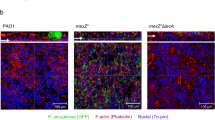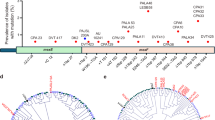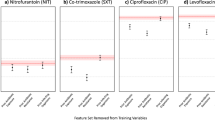Abstract
There are several mechanisms for antibiotic-resistant Pseudomonas aeruginosa. The purpose of this study is to investigate the association between the expression of efflux pump-coding genes and antibiotic resistance in P. aeruginosa causing urinary tract infections (UTIs). We extracted the RNA from 105 clinical strains of P. aeruginosa isolated from UTI patients with full data on antibiotic MICs and assayed real-time quantitative reverse-transcription PCR. We investigated the gene expressions of four resistance nodulation cell division-type multi-drug efflux pump systems (MexAB-OprM, MexCD-OprJ, MexEF-OprN and MexXY(-OprA)) and the correlation of the MICs of nine antibiotics, risk factors and antibiotic resistance-related genes with expressions of mexB, mexC, mexE and mexY. Multivariate statistical data demonstrated a significant relationship between increased expression of mexB or mexC and complicated UTI (Odds ratio=8.03, P<0.001 and Odds ratio=8.86, P=0.032, respectively). We also found a significant association between the increased expression of mexC and resistance to levofloxacin (LVFX) (Odds ratio=4.48, P=0.035). In conclusion, increased expression of mexC leads to LVFX resistance in P. aeruginosa causing UTI. These results contribute to our knowledge of the efflux pump system and antibiotic resistance.
Similar content being viewed by others
Log in or create a free account to read this content
Gain free access to this article, as well as selected content from this journal and more on nature.com
or
References
Hsueh, P. R. et al. Consensus review of the epidemiology and appropriate antimicrobial therapy of complicated urinary tract infections in Asia-Pacific region. J. Infect. 63, 114–123 (2011).
Lu, P. L. et al. Epidemiology and antimicrobial susceptibility profiles of Gram-negative bacteria causing urinary tract infections in the Asia-Pacific region: 2009-2010 results from the Study for Monitoring Antimicrobial Resistance Trends (SMART). J. Antimicrob. Agents 40, S37–S43 (2012).
Xiao, M. et al. Antimicrobial susceptibility of Pseudomonas aeruginosa in China: a review of two multicentre surveillance programmes, and application of revised CLSI susceptibility breakpoints. Int. J. Antimicrob. Agents 40, 445–449 (2012).
Lister, P. D., Wolter, D. J. & Hanson, N. D. Antibacterial-resistant Pseudomonas aeruginosa: clinical impact and complex regulation of chromosomally encoded resistance mechanisms. Clin. Microbiol. Rev. 22, 582–610 (2009).
Piddock, L. J. Multidrug-resistance efflux pumps—not just for resistance. Nat. Rev. Microbiol. 4, 629–636 (2006).
Poole, K. Multidrug efflux pumps and antimicrobial resistance in Pseudomonas aeruginosa and related organisms. J. Mol. Microbiol. Biotechnol. 3, 255–264 (2001).
Morita, Y., Tomida, J. & Kawamura, Y. Primary mechanisms mediating aminoglycoside resistance in the multidrug-resistant Pseudomonas aeruginosa clinical isolate PA7. Microbiology 158, 1071–1083 (2012).
Li, X. Z., Nikaido, H. & Poole, K. Role of MexA–MexB–OprM in antibiotic efflux in Pseudomonas aeruginosa. Antimicrob. Agents Chemother. 39, 1948 (1995).
Li, X. Z., Barré, N. & Poole, K. Influence of the MexA-MexB-oprM multidrug efflux system on expression of the MexC-MexD-oprJ and MexE-MexF-oprN multidrug efflux systems in Pseudomonas aeruginosa. J. Antimicrob. Chemother. 46, 885–893 (2000).
Poole, K., Krebes, K., McNally, C. & Neshat, S. Multiple antibiotic resistance in Pseudomonas aeruginosa: evidence for involvement of an efflux operon. J. Bacteriol. 175, 7363–7372 (1993).
Morita, Y. et al. Induction of mexCD-oprJ operon for a multidrug efflux pump by disinfectants in wild-type Pseudomonas aeruginosa PAO1. J. Antimicrob. Chemother. 51, 991–994 (2013).
Poole, K. et al. Overexpression of the mexC-mexD-oprJ efflux operon in nfxB-type multidrug-resistant strains of Pseudomonas aeruginosa. Mol. Microbiol. 21, 713–724 (1996).
Köhler, T. et al. Characterization of MexE–MexF–OprN, a positively regulated multidrug efflux system of Pseudomonas aeruginosa. Mol. Microbiol. 23, 345–354 (1997).
Muller, C., Plésiat, P. & Jeannot, K. A two-component regulatory system interconnects resistance to polymyxins, aminoglycosides, fluoroquinolones, and β-lactams in Pseudomonas aeruginosa. Antimicrob. Agents Chemother. 55, 1211–1221 (2011).
Sacha, P. et al. Expression of MexAB-OprM efflux pump system and susceptibility to antibiotics of different Pseudomonas aeruginosa clones isolated from patients hospitalized in two intensive care units at University Hospital in Bialystok (northeastern Poland) between January 2002 and December 2009. APMIS 122, 931–940 (2014).
Aeschlimann, J. R. The role of multidrug efflux pumps in the antibiotic resistance of Pseudomonas aeruginosa and other gram-negative bacteria. Pharmacotherapy 23, 916–924 (2003).
Matsumoto, M. et al. Mutations in the gyrA and parC genes and in vitro activities of fluoroquinolones in 114 clinical isolates of Pseudomonas aeruginosa derived from urinary tract infections and their rapid detection by denaturing high-performance liquid chromatography. Int. J. Antimicrob. Agents 40, 440–444 (2012).
CLSI—Clinical Laboratory Standards Institute. Performance standards for antimicrobial susceptibility testing: M100-S19. Clinical Laboratory Standards Institute Wayne, PA (2009).
Fernández, L. & Hancock, R. E. Adaptive and mutational resistance: role of porins and efflux pumps in drug resistance. Clin. Microbiol. Rev. 25, 661–681 (2012).
Poole, K. Pseudomonas aeruginosa: resistance to the max. Front. Microbiol. 2, 65 (2011).
Tomás, M. et al. Efflux pumps, OprD porin, AmpC beta-lactamase, and multiresistance in Pseudomonas aeruginosa isolates from cystic fibrosis patients. Antimicrob. Agents Chemother. 54, 2219–2224 (2010).
Yasufuku, T. et al. Correlation of overexpression of efflux pump genes with antibiotic resistance in Escherichia coli strains clinically isolated from urinary tract infection patients. J. Clin. Microbiol. 49, 189–194 (2011).
Ozer, B., Duran, N., Onlen, Y. & Savas, L. Efflux pump genes and antimicrobial resistance of Pseudomonas aeruginosa strains isolated from lower respiratory tract infections acquired in an intensive care unit. J. Antibiot. (Tokyo) 65, 9–13 (2012).
Han, J. H. et al. Risk factors for efflux pump overexpression in fluoroquinolone-resistant Escherichia coli. J. Infect. Dis. 206, 1597–1603 (2012).
Gorgani, N., Ahlbrand, S., Patterson, A. & Pourmand, N. (2009) Detection of point mutations associated with antibiotic resistance in Pseudomonas aeruginosa. Int. J. Antimicrob. Agents 34, 414–418 2009.
Sadeghifard, N. et al. Relationship between the presence of the nalC mutation and multidrug resistance in Pseudomonas aeruginosa. Int. J. Microbiol. 2012, 575193 (2012).
Kiser, T. H., Obritsch, M. D., Jung, R., MacLaren, R. & Fish, D. N. Efflux pump contribution to multidrug resistance in clinical isolates of Pseudomonas aeruginosa. Pharmacotherapy 30, 632 (2010).
Shigemura, K. et al. Does mutation in gyrA and/or parC or efflux pump expression play the main role in fluoroquinolone resistance in Escherichia coli urinary tract infections?: A statistical analysis study. Int. J. Antimicrob. Agents 40, 516–520 (2012).
Masuda, N. et al. Contribution of the MexX-MexY-oprM efflux system to intrinsic resistance in Pseudomonas aeruginosa. Antimicrob. Agents Chemother. 44, 2242–2246 (2000).
Morgan-Linnell, S. K., Becnel Boyd, L., Steffen, D. & Zechiedrich, L. Mechanisms accounting for fluoroquinolone resistance in Escherichia coli clinical isolates. Antimicrob. Agents Chemother. 53, 235–241 (2009).
Tam, V. H. et al. Prevalence, mechanisms, and risk factors of carbapenem resistance in bloodstream isolates of Pseudomonas aeruginosa. Diagn. Microbiol. Infect. Dis. 58, 309–314 (2007).
Pasca, M. R. et al. Evaluation of fluoroquinolone resistance mechanisms in Pseudomonas aeruginosa multidrug resistance clinical isolates. Microb. Drug Resist. 18, 23–32 (2012).
Acknowledgements
We thank Dr Masanori Kameoka for technical support. This study was supported by a grant-in-aid from the Program of Founding Research Centers for Emerging and Reemerging Infectious Diseases, the Ministry of Education, Culture, Sports, Science and Technology, Japan.
Author information
Authors and Affiliations
Corresponding author
Additional information
Supplementary Information accompanies the paper on The Journal of Antibiotics website
Supplementary information
Rights and permissions
About this article
Cite this article
Shigemura, K., Osawa, K., Kato, A. et al. Association of overexpression of efflux pump genes with antibiotic resistance in Pseudomonas aeruginosa strains clinically isolated from urinary tract infection patients. J Antibiot 68, 568–572 (2015). https://doi.org/10.1038/ja.2015.34
Received:
Revised:
Accepted:
Published:
Issue date:
DOI: https://doi.org/10.1038/ja.2015.34
This article is cited by
-
The Role of MexCD-OprJ and MexEF-OprN Efflux Systems in the Multiple Antibiotic Resistance of Pseudomonas aeruginosa Isolated from Clinical Samples
Current Microbiology (2023)
-
Metabolic fitness landscapes predict the evolution of antibiotic resistance
Nature Ecology & Evolution (2021)
-
Development of in vitro resistance to fluoroquinolones in Pseudomonas aeruginosa
Antimicrobial Resistance & Infection Control (2020)
-
Sequencing-based methods and resources to study antimicrobial resistance
Nature Reviews Genetics (2019)
-
MIC score, a new tool to compare bacterial susceptibility to antibiotics application to the comparison of susceptibility to different penems of clinical strains of Pseudomonas aeruginosa
The Journal of Antibiotics (2016)



